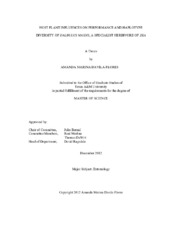| dc.description.abstract | In one study, a suite of plants from the maize genus Zea L. (Poaceae) and the specialist herbivore Dalbulus maidis (DeLong and Wolcott, 1923) (Hemiptera: Cicadellidae) were used to test the hypotheses that anti-herbivore defenses are affected by plant life-history evolution and human intervention through domestication and breeding for high yield. The suite of Zea host plants included one Mexican commercial hybrid maize Zea mays ssp. mays L., a landrace variety of maize, two populations of Balsas teosinte (Zea mays ssp. parviglumis Iltis & Doebley), and perennial teosinte (Z. diploperennis Iltis, Doebley & Guzman). This suite of host plants includes three Transitions evident within the genus Zea: life history form perennial to annual life cycle evident between perennial teosinte and Balsas teosinte, domestication transition from wild annual to domesticated annual evident between Balsas teosinte and landrace maize, and; breeding transition from landrace cultivar to a hybrid cultivar. The transitions were correlated with differences in plant defenses, as indicated by corn leafhopper performance. Results showed a performance gradient, suggesting a pattern in which plant defense is stronger in perennial than annual plants, Balsas teosinte than landrace maize, and in landraces than in hybrid maize. Furthermore, results suggested that domesticated maize would be the least defended, most suitable host for corn leafhopper.
In a second study, haplotype diversity was assessed to address structuring and interconnectedness among samples of corn leafhopper collected in the southwestern region of Mexico to address microevolution. The geographic focus of the study was maintained within an area encompassing the presumed centers of radiation of Dalbulus and its host genus Zea, and of maize domestication. Samples were complemented with samples of corn leafhopper sequences available at GenBank. Results revealed seven haplotypes from three host plants within Zea: perennial teosinte, Balsas teosinte, and maize. Furthermore, genetic differentiation was present and haplotype diversity appears to correlate with differences in genetic structure between perennial teosinte and maize. One haplotype was found to be present throughout all sites, which appears to parallel the spread of maize cultivation. As maize cultivation spread beyond its area of domestication, corn leafhoppers colonized perennial teosinte, further suggesting that subsequent decreases in maize cultivation in perennial teosinte habitat created a refuge where perennial teosinte- adapted haplotypes could persist. Altogether, my research suggests that the combination of historical expansion of maize cultivation expansion and the weaker anti-herbivore defenses associated within maize domestication appears to have favored genotypes particularly adapted for exploiting maize. | en |


